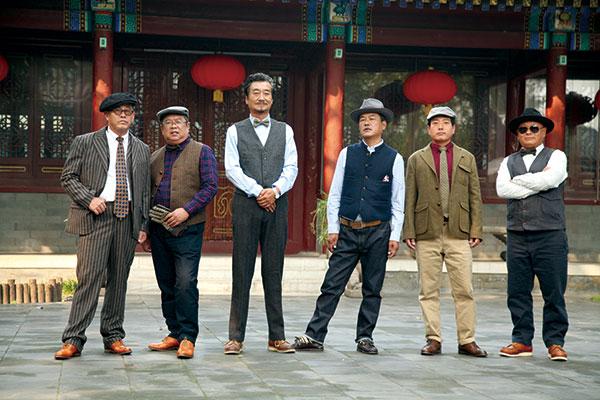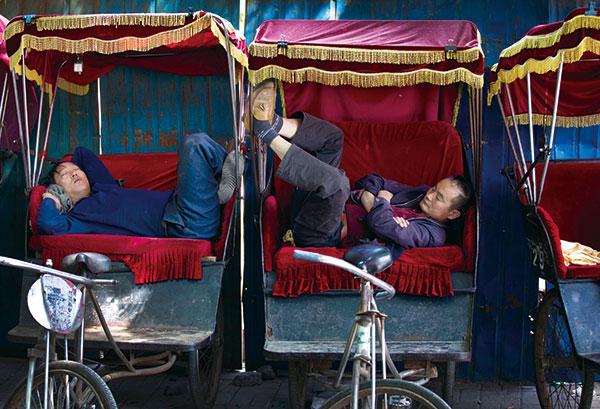During the 1970s and 1980s, in the era of the planned economy, many future members of “Houhai Baye” worked for government institutions and State-owed companies. First Master Wen worked for the Machinery Bureau of Beijing, Second Master Chang in a building decoration firm, and Third Master Zhang as an ironsmith in a State-owned factory.
As Reform and Opening up deepened, the once secure positions no longer offered jobs for life. A huge number of surplus workers were fired and tossed into the labor market. Among the future Houhai Baye, Wen, Chang, Third Master Li and Seventh Master Yang were forced to leave their positions.
On the chilly morning of November 11 2003, Third Master Li Yongfu set out on his first day as a pedicab driver. It cost him 350 yuan to buy the used pedicab. His wife made a blanket herself and placed it on the cycle for customers to keep warm.
Wearing spectacles, he looked educated and urbane, with the air of an office clerk. On his first day, he was extremely embarrassed when running into old neighbors and friends.
“Why are you doing this? There are plenty of other things you could choose to do. Why this?” Faced with a confused inquisition from neighbors, he wanted to sink into the ground with shame.
It wasn’t until noon that he made his first deal – giving a woman and a foreigner a hutong tour, paying 40 yuan each. In 2003, that was enough to eat for a week in Beijing.
Li lost his job at 43. As the breadwinner for the whole family, he had no choice but to find a new way to make a living. “Most people in our generation didn’t have the skills needed or a sense of how to do business. We were completely at a loss when facing an increasingly market-oriented society. Since driving a pedicab could make money near my home, I chose it in the end,” Li told NewsChina.
Hutong tours emerged in the 1990s. In 1994, local photographer Xu Yong, who was known for photographing hutong scenes, started up a cultural development company, which was the first enterprise in China to offer hutong pedicab tours.
It took Xu more than two years to apply for a hutong tour certificate. The biggest obstacle Xu encountered was that the authorities thought the tours were pointless, since compared to those magnificent historical and scenic spots in Beijing, hutongs were nothing but ragged alleys and dilapidated courtyard houses. After two years of efforts, Xu eventually convinced the authorities of the value of hutong culture.
A History of Their Own
“Past this corner we will see the former residence of Zhang Zhidong, who was an eminent official in the late Qing Dynasty, and also an advocate of China’s modernization and one of the founders of China’s heavy industry…” Li said one time, pattering to a customer as usual.
“Zhang Zhidong was a marvelous man! He was one of the Four Great Officials in the late Qing dynasty,” the customer exclaimed. Not knowing who the “Four Great Officials” were, Li learned from his customer that the other three great officials were Li Hongzhang, Zuo Zongtang and Zeng Guofan.
“Confucius said, ‘In a party of three, there must be one I can learn from.’ Us locals should know our own history clearly. If customers ask you three questions and you don’t know how to answer two and a half of them, that’s too shameful,” said Li. In order to better guide his tour, he reads newspapers every day, and when he finds stories related to Shichahai, he always clips them and puts them inside his books.
There are about 300 pedicab drivers in the Shichahai area, most of whom are migrant workers. Beijing-born drivers are few. The various Chinese dialects and the imaginatively told – and often inaccurate – tales recounted by drivers can be amusing, but they are also frustrating for professionals.
The amateur tour guides, their stories full of mistakes, make the Houhai Baye quite indignant. Li once heard a driver introducing Kaorouji as “the oldest restaurant in Shichahai, an old brand which has lasted through the Yuan, Ming and Qing dynasties, with more than 160 years of history…” “How can the three dynasties of Yuan, Ming and Qing only last a hundred years?” Li grumbled, knowing that the three dynasties collectively lasted more than six centuries.
The predecessors of pedicabs were rickshaws, drawn by pure manpower rather than the combination of machinery and pedaling (or engines) in the pedicabs today. The first rickshaw business in Beijing emerged in the 1930s. It was a common and cheap means of transportation till the beginning of the 1980s. Many describe Houhai Baye as the “Modern ‘Camel Xiangzi’,” a fictional rickshaw puller in the renowned Beijing-born Chinese author Lao She’s classic novel, Rickshaw Boy, which was published in 1937.
But Li doesn’t like the analogy. “That’s not the same. Today’s “rickshaw men” are the ones who promote the culture of Shichahai and old Beijing. We don’t do it just to make a living” Li told NewsChina.
As more and more migrants – bar singers, waiters, and peddlers – move into the hutongs, spending around 2,000 yuan (US$296) per month to rent a single room of a courtyard house, many local residents moved out. Some of the Houhai Baye have the finances and the opportunity to move to newly built apartments, but they still insist on staying where they were born.
“If I moved away, I would get sick!” Fifth Master Song cannot get used to apartment living. He feels dizzy when looking down from the thirteenth floor. He sticks to pedicab driving not only as a means to make a living, but to exercise his body. He feeds the birds, walks the dog, chews the fat with old neighbors, and buys the same lottery number every week. “That’s what life should be!” said Song.
Big Master Wen told our reporter that he is in his fifties, but physically 30 and mentally 20. The oldest of the eight, Third Master Li, retired this year. His family strongly urged him to rest since they knew that his right knee, due to long years of pedaling, had been painful for the last six months. Now Li has become the spokesman of the Houhai Baye team and also takes charge of teaching newly recruited drivers about Houhai culture.
The eight aged masters are eager to find successors. They started a “Houhai Baye Jr.” project a few years ago in the hope of recruiting educated college graduates and even foreigners to better promote hutong culture, but received few responses. This year, after the Beijing Design Week, “Houhai Baye Jr.’s Hutong Memories Salvation Association” was established, hoping to find more young people who love hutong culture and history.
“The true beauty of Shichahai is in its culture. If one day the eight of us all have to leave our pedicabs, I hope that the culture of the old Beijing city, the culture of Shichahai, can still be passed on,” Li said, his voice suddenly serious.

 Old Version
Old Version

